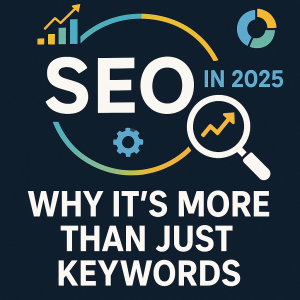
For years, SEO has been reduced to a few oversimplified tactics. You’ve probably heard things like:
-
“Just add some keywords.”
-
“Get green lights on Yoast.”
-
“Let’s write a blog and rank #1?”
-
“Can’t we just buy some backlinks?”
However, SEO in 2025 is a completely different beast. Search engines—and more importantly, user behavior—have evolved so much that these shortcuts no longer cut it. To win today, SEO requires strategy, depth, and a holistic approach.
So, what does SEO really involve today?
First, it’s no longer about chasing hacks. Instead, it’s about understanding your Total Addressable Search Market and building a roadmap for sustainable growth. Tools like Google Search Console give you real insights into performance, but only if you know how to use them correctly. For example, “don’t change URLs” recklessly—because stability often beats constant tinkering.
Next, quick wins do exist, but they come from quick-win keywords backed by solid customer research, not guesswork. In fact, strategies like programmatic SEO and entity optimization now help websites scale content while maintaining relevance and authority.
Moreover, with the rise of LLMs (Large Language Models), even LLM optimization is entering the picture—making sure your brand surfaces in AI-generated answers. Complementing this, keyword insights and topical authority play a critical role in ensuring Google sees your site as a trusted source.
The technical backbone of SEO
Of course, SEO isn’t just content. Behind the scenes, strong site architecture ensures that crawlers and users can easily navigate your site. Techniques like schema markup, along with monitoring Core Web Vitals, improve visibility and user experience.
Additionally, monthly activities such as reports, log file analysis, and keeping up with Google updates ensure you’re not left behind when the algorithm changes. Even subtle signals like brand mentions can influence your authority.
On the technical side, tools like Screaming Frog uncover hidden issues, while technical audits reveal weaknesses that impact performance. You’ll also need to address content decay, strengthen internal linking, and keep XML sitemaps updated for maximum crawlability.
Content, intent, and authority
Another key shift in 2025 is Google’s deeper understanding of search intent. Simply writing long blogs isn’t enough—you must structure content into topic clusters that show breadth and depth. Paired with digital PR, mentions, and link building, this helps establish both authority and trust.
At the same time, factors like E-E-A-T (Experience, Expertise, Authoritativeness, Trustworthiness) are no longer buzzwords—they’re the foundation of ranking. Whether you’re using canonicals, optimizing your robots.txt, or even experimenting with the new llms.txt file, every detail now matters.
The truth about SEO in 2025
In short, SEO is not about tricking algorithms—it’s about aligning with them while serving users better than anyone else. Just adding keywords or chasing green lights on Yoast will not deliver results anymore.
Instead, true SEO is about combining strategy, technical depth, and holistic marketing. It’s an ongoing process of refinement, adaptation, and smart execution.
So, the next time someone asks, “Can’t we just buy some backlinks?”—you’ll know the answer.
Because in 2025, real SEO doesn’t depend on shortcuts. It depends on doing the work.
Next Blog – How to Run High-Converting Google Ads Campaigns
